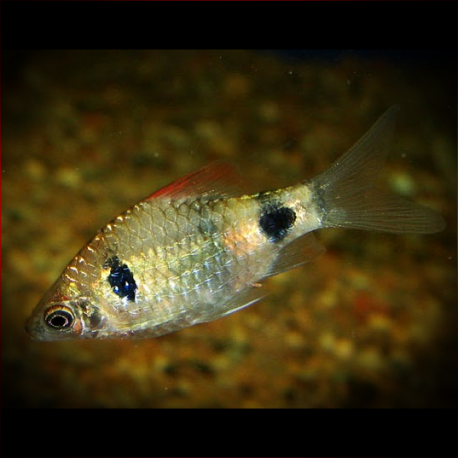More info
Datasheet
| Minimum Tank Size | 80 litres / 21.13 US gallons |
| Maximum Size | 6.5cm / 2.56inches |
| Temperature | 20°C / 68.00°F - 26°C / 78.80°F |
| Hardness | 5.04dgH / 90ppm - 15.02dgH / 268ppm |
| pH | 6.0-7.5 |
General Description
The Narayan Barb, scientifically known as Pethia Setnai, is an attractive and peaceful species belonging to the Cyprinidae family. With a maximum size of 6.5cm, this species is commonly found in hill streams and rivers in the Western Ghats mountains, particularly in backwater pools and slower-moving areas. The Narayan Barb is a schooling fish that thrives in a community aquarium setting.
Aquarium Setup
The Narayan Barb thrives in an aquarium with a minimum size of 80 litres, decorated to mimic its natural habitat. A substrate of sand or gravel, water-worn rocks, driftwood, and hardy plants like Microsorum or Anubias spp. can be added for a natural feel. Lighting can be subdued, and water conditions should be maintained within a temperature range of 20-26°C, pH of 6.0-7.5, and hardness of 90-268ppm.
Behaviour
As a schooling species, the Narayan Barb is most comfortable when kept in groups of 8-10 individuals. This fish is peaceful and can be housed with various other popular aquarium species, displaying its best colors when kept in decent numbers. Males may compete for female attention within the group, leading to an engaging and natural display in the aquarium.
Feeding and Diet
The Narayan Barb is likely an omnivorous forager, feeding on small invertebrates, plant material, and organic detritus in the wild. In captivity, they readily accept a diet of small live and frozen foods such as bloodworms, Daphnia, and Artemia, along with high-quality dried flakes and granules. A varied diet that includes plant or algal content ensures their nutritional needs are met.
Reproduction & Dimorphism
This species is an egg-scattering free spawner that exhibits no parental care. To maximize breeding success, a separate breeding tank with dim lighting and spawning substrate is recommended. Adult males are slightly smaller, slimmer, and more brightly colored than females. Females can produce eggs frequently, with fry hatching within 24-48 hours post-spawning and requiring infusoria-grade food initially.
Habitat and Distribution
The Narayan Barb is commonly found in rivers draining the Western Ghats mountains in India. They inhabit flowing sections of hill streams and rivers, sharing their habitat with various other fish species. Favoring backwater pools and deeper, slower-moving areas, the species experiences variations in water flow, volume, and turbidity during the annual monsoons.

